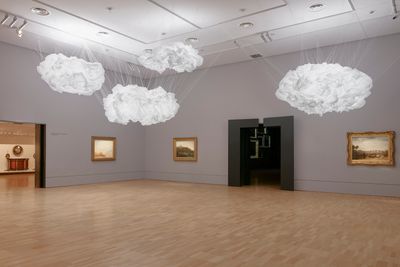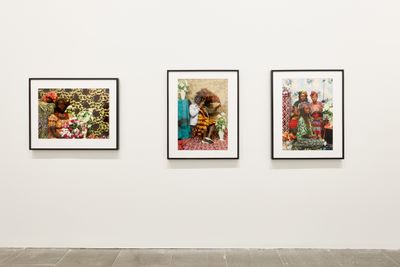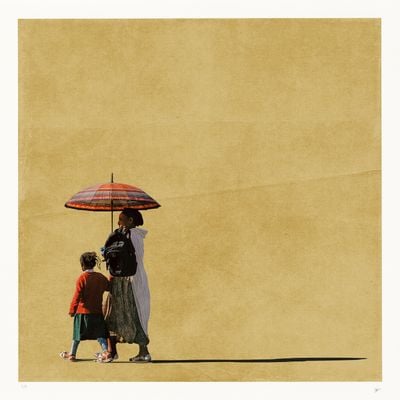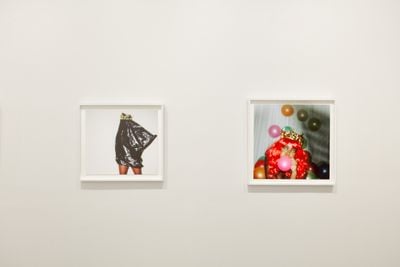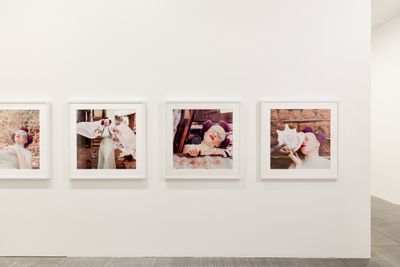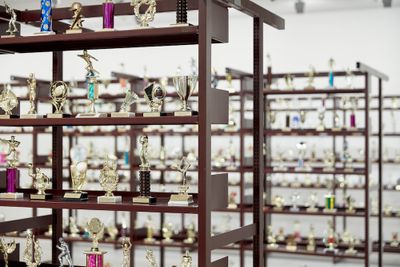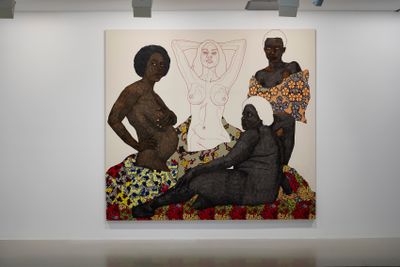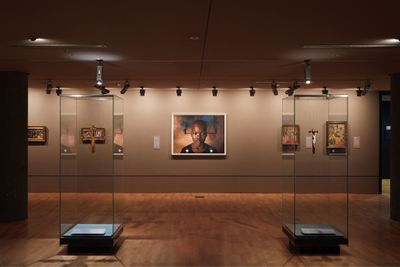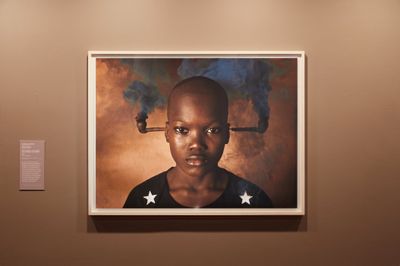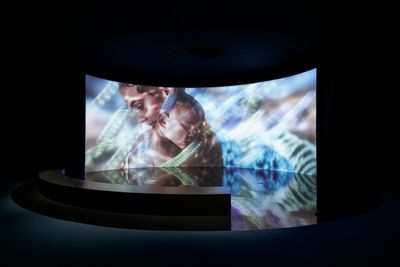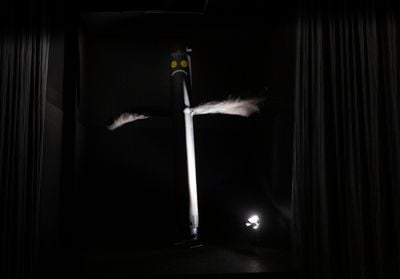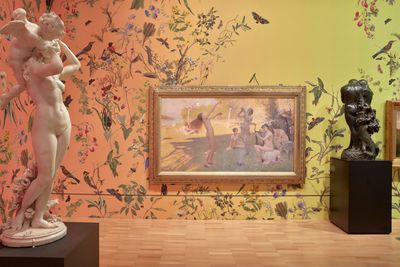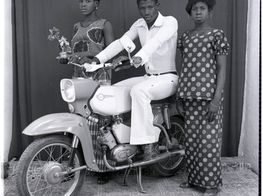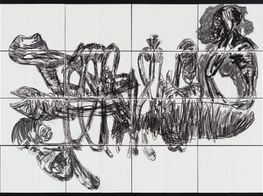NGV Triennial 2020 Misses the Moment
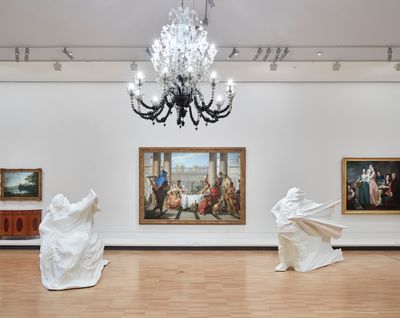
Daniel Arsham, Hidden figures (2020) and Fred Wilson, To die upon a kiss (2011) (foreground). Exhibition view: NGV Triennial 2020, NGV International, National Gallery of Victoria, Melbourne (19 December 2020–18 April 2021). Courtesy © the artist and Perrotin; courtesy © the artist and Pace Gallery. Photo: Sean Fennessy.
A sentiment that is well known, shared, and held, yet fails to assert itself as unequivocal and plain, is the oxymoron of any city or state's national gallery.
The paradox lies in the overbearance of the institution as the most visibly prominent arts entity in any given location, receiving most of any available arts funding or budget, public legitimacy as an arts producer, and most jarringly the least responsibility to its de facto position as spokesperson for that city or state's acceptable artistic practice.
The National Gallery of Victoria often presents itself as a middle space between grassroots, community arts practices and organisations, and the government institution it ostensibly is. This leads to an awkward refusal to acknowledge that it is a suit-and-tie office worker concerned with capital output, clout, and Key Performance Indicators that no amount of too-cleanly applied tattoos, overpriced fashion, and blaring of underground rap music from a Mercedes-Benz (even with a vinyl decal of a featured contemporary artwork across the body) can cover.
The NGV Triennial 2020 (19 December 2020–18 April 2021), presenting 86 projects by over 100 artists, follows in this form—a lacklustre presentation full of the lack of imagination that institutional positionality demands, replete with an infantilising patronisation of its audience and an arbitrary categorisation of art and artist that betrays its ethnographic, colonial heritage as the art department of a settler colonial government.
One assumes, from the exhibition's promise of 'a visually arresting and thought-provoking view of the world at this unique moment,' and with news that the gallery will receive a share of the AUD $1.46 billion earmarked for the transformation of its arts centre, that this is an organisation in command of a sense of the import of spatial design within its curatorial remit.
It is then disconcerting to apply this assumption to the most glaring aspect of this exhibition, wherein the over life-size stainless-steel mirror-polished spangle of Jeff Koons' Venus (2016–2020) is permitted a full, bare-walled room, while some way through the exhibition a slanted corridor not more than three metres across holds the full roster of this exhibition's Black photographers.
A poignant statement, deliberate or otherwise, that this national gallery's state government sought to hasten and increase the co-morbidities of its First Nations, Black, and migrant communities time and again.
The collection of images, two to three artists per wall, includes the colourful patterns of Atong Atem's 'Studio Series' (2015), with portraiture reminiscent of Malick Sidibé, whose style is similarly echoed in Aïda Muluneh's 'Memory of Hope' (2017), a series of three photographs in which figures are framed by sharp colour contrasts and geometric patterns, and five ultra-vibrant pieces from Girma Berta's photographic series 'Moving shadows' (2017), which capture subjects from the streets of Addis Abba isolated against flat planes of colour.
The strikingly contrasted presentations of Lakin Ogunbanwo's series 'Are We Good Enough' (2015–2017), of young men in traditional Nigerian caps photographed from behind, and three excerpts from Ayana V. Jackson's 'Intimate Justice in the Stolen Moment' (2017) series of the artist caught in mid-dance, leave barely enough room for Phumzile Khanyile's self-portraits in 'Plastic Crowns' (2016), and the muted-yet-colourful palette of Sarah Waiswa's 'Stranger in a familiar land' (2016), in which Florence Kisombe, an albino woman, is captured in various urban settings in Kenya.
Navigating this awkward corridor of otherwise fantastic works, a viewer might struggle to find any apparent thematic link other than that these are portraits of Black people made by Black photographers of the African Diaspora.
In facing this, there is something all too familiar about the process the even slightly critical observer must engage with: choose social safety in the path of least inequality awareness, and opt to believe the curatorial choice in this grouping is only accidentally spatially reductive and not also racially reductive. That is, not a lazy, white-authored monolithing of Blackness, nor the reflection of how that notion can be found on the surface of Melbourne's societal common thought.
Beyond the corridor is Lenapehoking-based artist Diamond Stingily's In the middle but in the corner of 176th place (2019), a large-scale reflection on 'society's collective obsession with triumph, competition and failure' as a gallery-sized trophy room filled with over 700 athletic trophies placed on metal shelving units.
One has to seek out extreme generosity to entertain these positionings as attempting to radically challenge or spark non-reformist dialogues around history...
On exiting this at times humorous at others humbling statement, the first inklings of what comes to feel all but intentional makes itself apparent: this exhibition is made for Instagram. If not that, then its curation is in line with the pop-y imagery, aestheticism, and conflation of consumption habits as praxis one might find on that platform's explore page.
Besides Koons's Venus, this feeling is most tangible in works like Porky Hefer's Plastocene – Marine Mutants from a disposable world (2020)—a dystopian imagining of the post-Anthropocene era, including an octopus, measuring 14 metres across, constructed from giant hand-felted cigarette butts. But to clarify: this is not an indictment on the work displayed, 'accessibility' within the arts, nor Instagram use, but on what comes across as an art institution's shallow interpretation of its role in the state's art practice hierarchies, which drowns out much of the abundant quality found in many of the pieces exhibited.
Instead, safety in the familiar is foregrounded over any real embrace of the radical or progressive, disturbing or disruptive, and performing all of the top-down, box-ticking curation and decision-making one expects in governmental administration.
Other jarring moments in this spirit of confused-bordering-antagonistic spatial curation are found in the haphazard placement of Pierre Mukeba's mixed media and large-format Impartiality (2018), situated in a low-ceilinged wing of the British & European Collection, which diminishes the impact of the work's scale, vibrancy, and inquisition.
The otherwise striking piece from the self-taught Congolese artist's exploration of socio-cultural standards and representations of beauty utilises brush pen textures on unprimed cotton cloth, with Dutch wax print sewn in to shroud the four Afro womxn depicted.
A particularly aggravating ethnographic display hung in the centre of the structural wall directly opposite the entrance to the British & European Collection of 14th–16th-century Roman Catholic paintings makes plain the complexity missing from the dialogues and dialectics that have informed this exhibition.
Cristina de Middel and Bruno Morais' The confusion of the pipes (2018) is a photographic print from the non-Black Latinx duo's recent 'Midnight at the crossroads' series, which purports to 'explore the evolution of traditional West African religions, popularly referred to as "voodoo", as they have been practiced over centuries by the African diaspora in South America and the Caribbean region.'
There isn't much left to the imagination as to what the shallow juxtapositional curatorial motives may have been in placing an image of a young Black person engaged in one of the many cultural traditions observed by the people of the Loa amid a visual history of Catholicism saturating this room.
One has to seek out extreme generosity to entertain these positionings as attempting to radically challenge or spark non-reformist dialogues around history, especially with an accompanying wall text describing the image as 'an unusual portrait ... suggesting a baffling and unnerving ceremonial event'.
Even more disheartening is the positioning at the very top and back of the gallery of two works on either side of the same wall that effectively shoulder what is missing throughout this exhibition.
Hannah Brontë's EYE HEAR U MAGIK (2020) is a mesmerising video installation exploring and at the same time insisting on Blak/Indigenous matriarchal futurism, knowledge, and intuition: a tapestry of scenes and settings under ocean waters and outer space populated by whales, mothers, child-bearers, and community, with a rich choral soundtrack ethereally binding this immersive offering.
Steven Rhall's Air dancer as black body (2020) is installed in a silent, pitch black room punctuated by an automatic light that illuminates a loudly inflating air dancer waving one of its arms as the other remains cuffed as it were against the wall—a short, sharp, sensory assault that responds to 'how non-white bodies appear in Eurocentric frameworks of art and culture.'
Falling on a year when renewed demands for Black/Indigenous liberation, autonomy, remuneration, and equal rights in 'Australia' have been met with mostly short-term neoliberal performances of solidarity, explicit state violence, policing and backlash, environmental destruction, and a deepening of liberal white tokenism, this show feels wildly misguided by the cacophony of its own echo chamber—apparently the first port of call in a society so detached from its Bla[c]k populous it knows only to extract or erase.
Ultimately, the NGV Triennial 2020 displays an extension and reflection of the mindset so prevalent in so-called 'Australia' and its dominant entities: a hollow overture to self-proclaimed excellence that always manages to centre the white gaze, push the envelope not in innovation but in safety, and breaking the barriers not of progress but of how much of a federal budget can be spent to keep the status quo scarcity just so.—[O]
Mukeba


